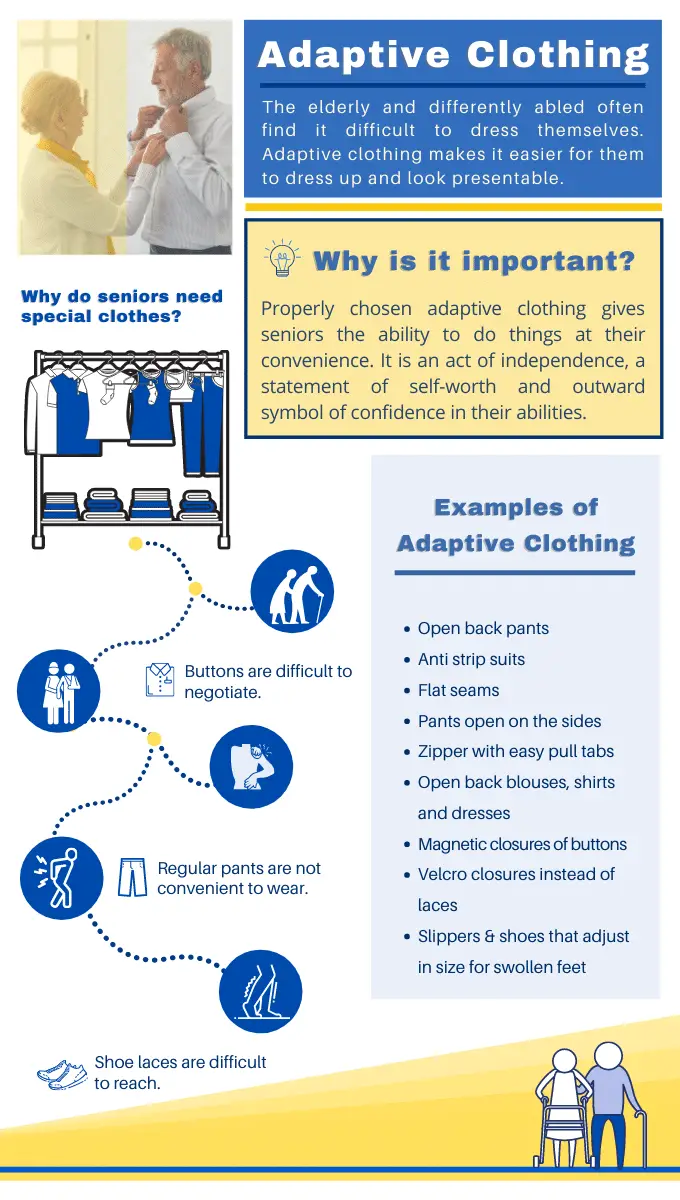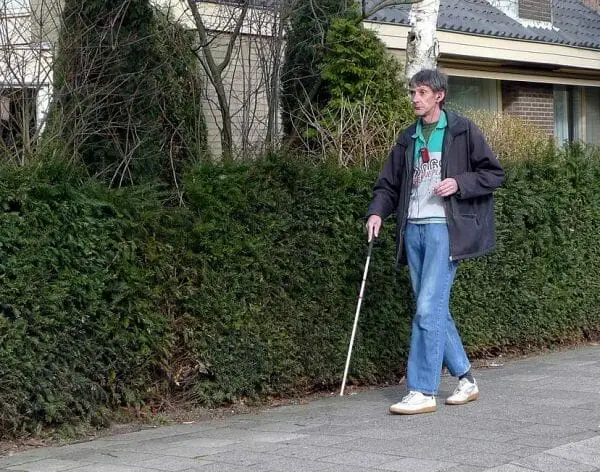Adaptive clothing for blind people can make those suffering from vision impairment, immensely independent and self sufficient.
In this article, we discuss the problems that blind face when buying clothing of their choice. We will also explore some of the adaptive clothing ideas geared towards making dressing up easier for them.
Contents
The WHO estimates that globally, about 2.2 billion people are afflicted with vision impairment or blindness1. According to the CDC, in the US alone, 12 million people over the age of 40 have vision impairment2.
For those with vision impairment, going to a shop and selecting clothes of their unique preferences, quality, style and functionality is a nightmare.
Not only are most stores woefully inadequate when it comes to adaptive clothing, they are also not equipped with the kind of equipment that lets the visually impaired experience the clothes through other senses and come to any sort of decision on what they would prefer.

Here we have a video below an example of an open back pants as an adaptive clothing.
What are the problems that the blind face while dressing?
For someone who has normal vision, it is difficult to imagine the kind of problems the blind face when selecting their wardrobe.
Choosing colors
For a person who has never suffered from vision impairment, selecting colors and texture is one of the most important criteria when buying clothes. Colors represent mood and fashion, confidence, style, and mark one’s unique way of interacting with the world.
We may think that colors are not that significant for the blind since they are not able to see them. But what we fail to realize is that while they may not see colors, the innate need of human beings to stand out from others in a crowd is as strong as anyone else for a blind person, especially since they already carry baggage that they would not like others to focus on.
Therefore, it is very important to give them away in which they could choose the colors and textures that they feel would make them stand out, without having to involve friends or depending on salespersons.

Right side out
We distinguish which side of the cloth is inside and which is out by simply looking at it. But for a blind person, it is the seam that indicates clearly which side is out and which is in! So, having the seam placed in a way that makes it easy to determine the right side is very important.
Similarly, walking sticks are a part and parcel of life for the visually impaired. However, what happens when such a person visits a restaurant or a coffee house?
Where do they keep the walking stick? If they are visiting the place for the first time, they may not know their way around and would have no idea where they could safely keep it.
In such a case, it is especially useful if their clothing has pockets built-in which can hold the stick (once folded up).
Texture
Another aspect is the softness and texture of clothing. People with visual disabilities tend to develop a much more sensitive tactile ability. What feels soft to us, may not be as great to them.
Touch is a more important fashion differentiator to them than other things like color and design because they can feel it for themselves instead of reading it off a braille description.
Therefore it may make sense to choose the softest possible blends when making adaptive clothing for the blind.
Then there are smart clothing options with GPS, Bluetooth and RFID technology that can not only assist the blind in selecting the right dress but can assist them in other daily tasks such as navigation, location and identifying day-to-day objects in front of them.
Buttoning and Fastening
Lastly, buttons, zippers, laces and other traditional methods of wearing clothes are difficult to operate for someone with limited visibility. There are smarter ways to put on our clothes, without messing around with buttonholes, shoelace loops and zippers.
You may also like Best EMF Protection Clothing
How Can Adaptive Clothing for the Blind Help?
In recent years, many young entrepreneurs and some major fashion labels have started researching and adapting their clothing to meet the needs of the blind. New and innovative solutions have cropped up, and today adaptive clothing for blind is a fast growing industry.
Experience drawn from talking to, and learning from, the blind themselves is helping entrepreneurs in designing the right adaptations to make fashion accessible and fun for them. Let us discuss some of the ideas that have come about in this process.
Here are some adaptive clothing suggestions available for order on Amazon.
Indicating colors
Several ways have come up to indicate not just colors but all those small pieces of information (how to wash, how to iron etc) that come as part of the clothing tag.
Embroideries made with beads, pallettes and tacks can be used to spell out the information on the surface of the dress – making it look visually appealing while also giving important information to the wearer
Braille tags have also been developed which can be attached to the garment tag to convey the entire information to the blind.
Knowing the inside and out of a dress
Seams are designed specially to keep the frayed side out on the inside end of the cloth. This helps the visually impaired to identify the right side easily, without having to ask a friend every time or becoming embarrassed if they wear it inside out.
A pocket to keep your walking stick
When a blind person goes to an unknown place, one of the problems they face is to keep their walking stick in a place where they will be able to easily find it. What better way than to be able to keep it in their clothes themselves?
A specially designed 23 cm pocket is useful for holding a walking cane or stick when you just want to sit down and relax, without having to worry about where to put your walking stick.
You may also like Clothing for Seniors With Limited Mobility
Softer textures for more refined tactile senses
Visually impaired people are known to develop tactile senses which are finer than the rest of us. They need dressing to match their finer sensibilities. At the same time, touch is one of the few ways they have to distinguish between different clothes since they don’t have access to either color or texture.
Shirts and fabrics have been designed to adapt to the special needs and sensibilities of the visually impaired by creating special blends of cotton and spandex with bamboo. These clothes are finer and more appealing to the touch than regular clothes.
Sensor enabled shoes to help assist the blind in walking
A recently developed, very useful piece of technology for the blind is the walking shoe that assists in walking without help, called “Lechal”. The shoes have a GPS chip embedded which vibrates left or right depending on the direction in which the wearer needs to turn. At the same time, it has a Bluetooth functionality to detect obstacles and alarm the wearer before touching them.
As the shoe works on Bluetooth technology, it does not need a working internet connection all the time, unlike many other devices. Here are some Bluetooth shoes you can order online.
Online shopping for adaptive clothes
Another recent trend is for the blind-friendly clothing website. The focus here is not on adaptive clothing but instead making the shopping experience adaptive.
If you visit such a site, you will be asked a few questions about what kind of clothes you want to buy (taking input through speech), and based on the answers, dresses and clothes will be suggested for you.
Once you place your order, braille cards will be put along with the clothes to explain what each cloth is, its particulars, instructions for washing and taking care of the cloth and any other special instructions.
You may also like Best Snap Front Robes for Seniors
Easy pull up tabs, button hooks for zippers and buttons
Zippers can be difficult to close and open if you can’t see the zipper fastener. Enter zipper tabs, with large, round loops at the end for easily inserting your finger and pulling the tab up and down. This small innovation brings so much pleasure in the lives of the people who have lost their sense of sight and is also useful for people who are struggling with dexterity in their fingers, or people with Parkinson’s or dementia.
Button hooks can help easy buttoning and unbuttoning of clothes. Here are some zipper tabs and button hooks available online.
Using velcro straps instead of shoelaces
Let’s face it, shoelaces are hard to tie. Especially so if you can’t see them. As a visually impaired person, bending down and tying your shoelaces while creating little loops and inserting one loop into the other!
Enter velcro straps – the easy and convenient way to tie your shoes closed without having to muck around with laces. Velcros straps are also useful as adaptive clothing fasteners in shirts, pants and pretty much any dress since they are much more convenient to use than traditional buttons and zippers.
Magnetic fasteners to replace buttons
Magnetic fasteners, like velcros straps, are lifesavers when compared with traditional buttons and zippers, since they close themselves when you bring one end of the button near the other end.
Another added advantage to magnetic fasteners is that they can be small in size and can be hidden easily to appear as though they are traditional buttons, which cannot be done with velcro straps. This makes the dress look normal, which is sometimes appreciated as an important aspect of dressing by the blind.
Here are some men’s and women’s shirts and dresses with magnetic fasteners, instead of buttons.
You may also like Best Front Close Bra for Elderly
Conclusion
Adaptive clothing is a boon for those who are disadvantaged physically but have the courage and the power of will to not let that disadvantage come in the way of going out and winning the world.
The innovations mentioned in this article are some of the many ideas that are helping the visually impaired live richer, fuller, more colorful lives, and the giving them the confidence that comes with knowing that in your own unique way – you look beautiful!
If you want to know more about adaptive equipment, you can read our articles on adaptive utensils.
We have covered mobility aids in a great detail. You can read our article about transport wheelchairs. If you want to know more about power wheelchairs, we have discussed narrow width power wheelchairs and wheelchairs that are good for outdoor use. Among mobility devices, especially for those who are out and about, we cover rollator walkers and knee scooters too.
We also have detailed reviews of the best hearing aids available.
We have a comprehensive resource for you if you feel tired of caring for elderly parents. The key is to make them more independent so that they can take care of themselves and you have more time to spend with them, rather than just running chores.




















